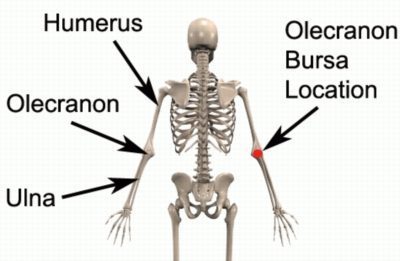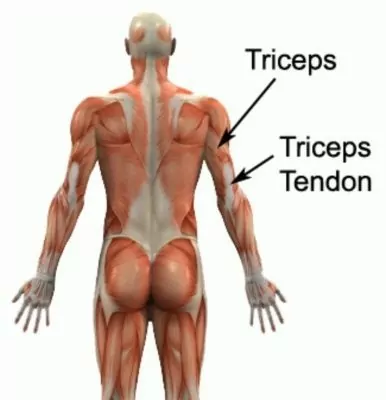Olecranon Bursitis
Updated:
(Also known as Student’s Elbow, Elbow Bursitis)
What is olecranon bursitis?
Olecranon bursitis is a condition characterized by tissue damage and inflammation of the olecranon bursa (a small fluid filled sac located at the back of the elbow) causing pain in the back of the elbow.
The elbow is formed primarily from the union of the humerus (upper arm bone) and the ulna (forearm bone). The ulna has a bony process situated at the back of the elbow known as the olecranon (figure 1). This bony prominence is a point of attachment of several muscles including the triceps (figure 2) and forms the outer most point of the back of the elbow. Between the olecranon and overlying skin lies a bursa known as the olecranon bursa (figure 1). A bursa is a small sac filled with lubricating fluid and is designed to reduce friction between adjacent soft tissue layers.


The triceps muscle is primarily responsible for straightening the elbow and is particularly active during pushing activities. During contraction of the triceps, friction is placed on the olecranon bursa. Pressure may also be placed on the olecranon bursa following a direct impact or leaning on the elbow. When these forces are excessive due to too much repetition or high force, irritation and inflammation of the bursa may occur. This condition is known as olecranon bursitis.
Causes of olecranon bursitis
Olecranon bursitis most commonly occurs due to repetitive or prolonged activities placing strain on the olecranon bursa. This typically occurs due to prolonged pressure on the bursa (such as repetitive falls on the elbow or prolonged resting of the elbow on hard surfaces) or due to repetitive pushing activities or straightening the elbow against resistance (placing strain on the bursa via the triceps tendon). Occasionally, the condition may occur suddenly due a direct blow to the elbow (such as a fall onto a hard surface).
Signs and symptoms of olecranon bursitis
Patients with olecranon bursitis typically experience pain and swelling in the back of the elbow. Pain typically increases when leaning on the affected elbow or when bending and straightening the elbow. In less severe cases, patients may only experience an ache or stiffness in the elbow that increases with rest following activities placing strain on the bursa. These activities typically include resting or falling on the elbow (particularly on hard surfaces), pushing activities, repetitive use of a hammer or straightening the elbow against resistance. The pain associated with this condition may also warm up with activity in the initial stages of injury.
As the condition progresses, patients may experience symptoms that increase during sport or activity. Patients may notice marked swelling and an appearance of a large bulge over the point of the elbow. Most patients with olecranon bursitis experience pain on firmly touching the olecranon bursa (figure 1). Occasionally small lumps may be felt over the point of the elbow. Patients may also experience weakness in the elbow particularly when attempting to straighten the elbow against resistance.
Diagnosis of olecranon bursitis
A thorough subjective and objective examination from a physiotherapist may be sufficient to diagnose olecranon bursitis. Further investigations such as an Ultrasound, X-ray, CT or MRI scan are often required to assist with diagnosis and assess the severity of the condition.
Prognosis of olecranon bursitis
Most patients with this condition heal well with appropriate physiotherapy and return to normal function in a number of weeks. Occasionally, rehabilitation can take significantly longer and may take many months in those who have had their condition for a long period of time. Early physiotherapy treatment is vital to hasten recovery in all patients with olecranon bursitis.
Treatment for olecranon bursitis

Members Only ContentBecome a PhysioAdvisor Member to gain full access to this exclusive content. For more details see Become a Member. Already a member? Login Now
Contributing factors to the development of olecranon bursitis
There are several factors which can predispose patients to developing this condition. These need to be assessed and corrected with direction from a physiotherapist. Some of these factors include:
- joint stiffness (particularly the elbow)
- muscle tightness (particularly the triceps)
- inappropriate or excessive training or activity
- inadequate recovery from training or activity
- inadequate warm up
- muscle weakness
- muscle imbalances
- inadequate rehabilitation following a previous elbow injury
Physiotherapy for olecranon bursitis
Physiotherapy treatment is vital to hasten the healing process, ensure an optimal outcome and reduce the likelihood of recurrence in all patients with this condition. Treatment may comprise:
- soft tissue massage
- dry needling
- electrotherapy (e.g. ultrasound, TENS etc)
- stretches
- joint mobilization
- ice or heat treatment
- the use of an appropriate compression bandage
- progressive exercises to improve strength, flexibility, posture and scapula stability
- education
- anti-inflammatory advice
- activity modification advice
- a gradual return to activity program
Other intervention for olecranon bursitis
Despite appropriate physiotherapy management, some patients with this condition do not improve adequately. When this occurs the treating physiotherapist or doctor will advise on the best course of management. This may include further investigations such as X-rays, ultrasound, MRI or CT scan, pharmaceutical intervention, corticosteroid injection, drainage of the bursa or referral to appropriate medical authorities who will advise on any interventions that may be appropriate to improve the condition. In rare and recurrent cases of this condition surgical removal of the bursa may be indicated.
Exercises for olecranon bursitis
The following exercises are commonly prescribed to patients with this condition. You should discuss the suitability of these exercises with your physiotherapist prior to beginning them. Generally, they should be performed 2 – 3 times daily and only provided they do not cause or increase symptoms.
Your physiotherapist can advise when it is appropriate to begin the initial exercises and eventually progress to the intermediate, advanced and other exercises. As a general rule, addition of exercises or progression to more advanced exercises should take place provided there is no increase in symptoms.
Initial Exercises
Elbow Bend to Straighten
Bend and straighten your elbow as far as you can go without pain and provided you feel no more than a mild to moderate stretch (figure 3). Repeat 10 times provided there is no increase in symptoms.

Forearm Rotations
Begin this exercise with your elbow at your side and bent to 90 degrees (figure 4). Slowly rotate your palm up and down as far as you can go without pain and provided you feel no more than a mild to moderate stretch. Repeat 10 times provided there is no increase in symptoms.

Intermediate Exercises

Members Only ContentBecome a PhysioAdvisor Member to gain full access to this exclusive content. For more details see Become a Member. Already a member? Login Now
Advanced Exercises

Members Only ContentBecome a PhysioAdvisor Member to gain full access to this exclusive content. For more details see Become a Member. Already a member? Login Now
Other Exercises

Members Only ContentBecome a PhysioAdvisor Member to gain full access to this exclusive content. For more details see Become a Member. Already a member? Login Now
Rehabilitation protocol for olecranon bursitis

Members Only ContentBecome a PhysioAdvisor Member to gain full access to this exclusive content. For more details see Become a Member. Already a member? Login Now
 Physiotherapy products for olecranon bursitis
Physiotherapy products for olecranon bursitis
Some of the most commonly recommended products by physiotherapists to hasten healing and speed recovery in patients with this condition include:
To purchase physiotherapy products for elbow bursitis click on one of the above links or visit the PhysioAdvisor Shop.
 Find a Physio
Find a Physio
Find a physiotherapist in your local area who can treat elbow bursitis.
 More Exercises
More Exercises
 More Information
More Information
- View detailed information on when to use Ice or Heat.
- Learn about initial injury management and the R.I.C.E. Regime.
- View comprehensive advice on Returning to Sport.
- Learn about Why your Injury may not be Improving.
- Read our Elbow Diagnosis Guide.
Become a PhysioAdvisor Member
-
 Individual Membership (12 Months)$59.95 for 1 year
Individual Membership (12 Months)$59.95 for 1 year -
 Individual Membership (3 Months)$39.95 for 3 months
Individual Membership (3 Months)$39.95 for 3 months -
 Individual Membership (Yearly)$49.95 / year
Individual Membership (Yearly)$49.95 / year -
 Individual Membership (Monthly)$15.95 / month
Individual Membership (Monthly)$15.95 / month

Link to this Page
If you would like to link to this article on your website, simply copy the code below and add it to your page:
<a href="https://physioadvisor.com.au/injuries/elbow-forearm/olecranon-bursitis”>Olecranon Bursitis – PhysioAdvisor.com</a><br/>Olecranon Bursitis (Elbow Bursitis) is a condition characterised by tissue damage and inflammation of the olecranon bursa causing pain in the back of the elbow.
Return to the top of Olecranon Bursitis.






